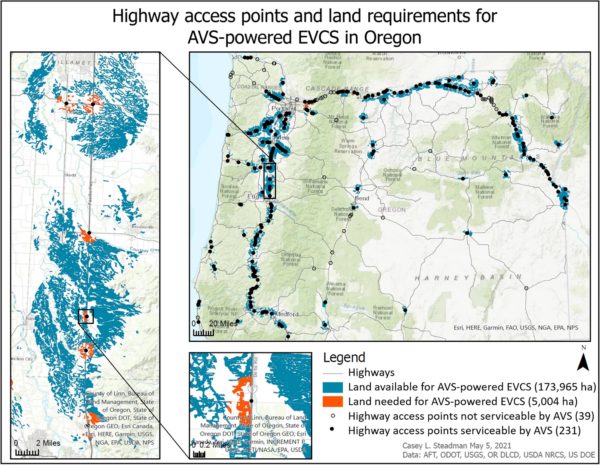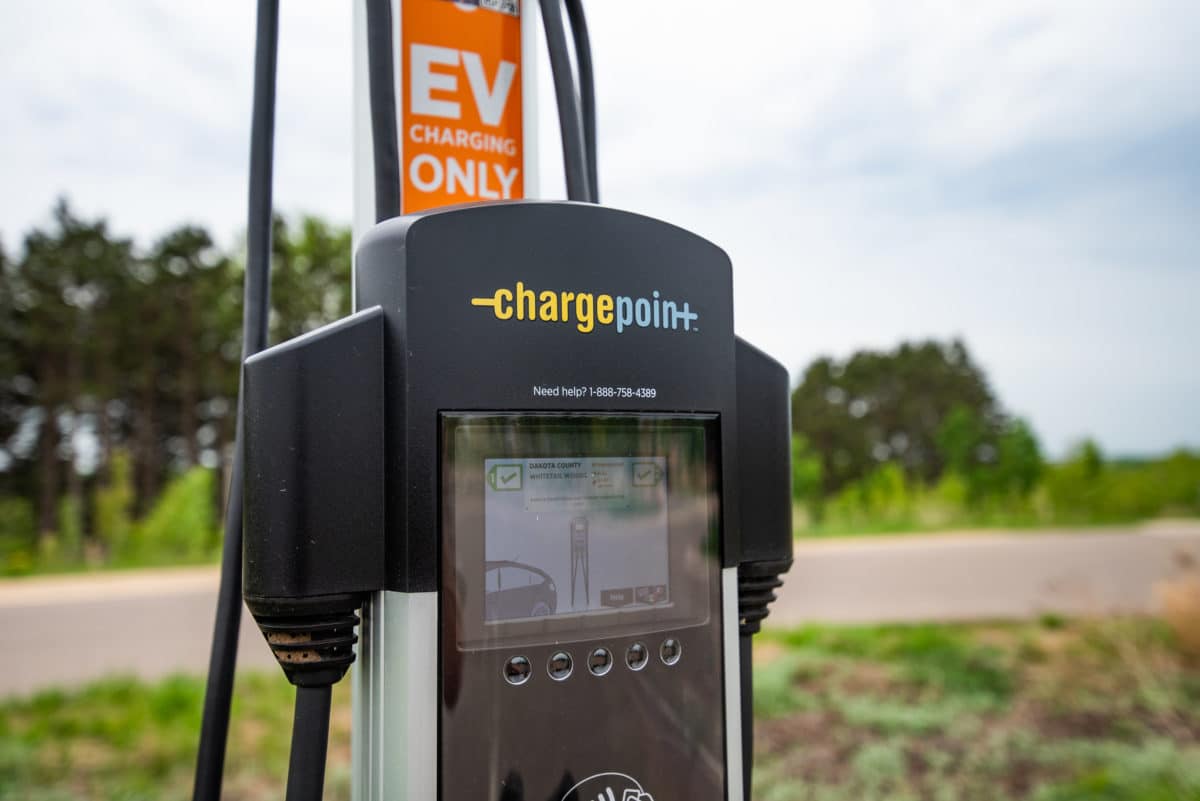A research team from Oregon State studied the potential of agricultural land to generate solar electricity to power electric vehicles along the state’s highways. They found that agrivoltaic systems placed in adjacent proximity to the highway can be useful in rural areas, which is also where electric charging stations are most needed.
The study, recently published in Scientific Reports, looked at how agrivoltaic technology can be used to improve EV charging infrastructure to reduce range anxiety, which is the worry about making it to the next charging point. In their analysis the team envisioned a scenario that had the highest traffic demand and the lowest photovoltaic generation, and the results showed that agrivoltaics could play a role in charging station infrastructure development.
In the study, a total of 231 rural highway access points were identified that had sufficient land area to service EV charging stations with energy generated by agrivoltaic installations. These areas are indicated with black circles Figure 1.

Image: Oregon State, Scientific Reports, Creative Commons License CC BY 4.0
The team discovered that to meet the conservative estimate of EV charging station demand at 86% of highway access points through Oregon, 12,000 acres (18.75 square miles) of land would be required. Of the 231 highway access points identified for agrivoltaics, 220 (95%) have a distance between them that is less than 17 miles. The researchers looked at earlier research conducted in Croatia that indicated that people have less range anxiety if charging stations are less than 3.1 miles apart. And other research shows that gas stations tend to be 2.5 to 18 miles apart. The Oregon State team used this range as a basis in their scenario.
Based on the number of vehicles registered in the state of Oregon and how much carbon they emit each year, the team estimated that the potential for carbon reduction through agrivoltaic-powered EV charging stations is about 3.1 million tons or the equivalent to 673,915 vehicles removed from the road each year, if their approach were fully implemented.
Overall the Oregon researchers showed that servicing rural EV charging stations with agrivoltaics next to the highway is feasible, requiring only 3% of total land supply to power 86% of rural highway access points throughout the state.
As rural areas often lack the grid infrastructure to support charging stations, agrivoltaics enable the shift in energy production to the point of use. Oregon currently has 670 EV charging stations, and the researchers’ scenario adds another 231 charge points located in close enough proximity to reduce or eliminate range anxiety. Additionally, the team estimates that implementation of this approach could reduce annual carbon emissions from passenger vehicle use in Oregon by 21%.
This content is protected by copyright and may not be reused. If you want to cooperate with us and would like to reuse some of our content, please contact: editors@pv-magazine.com.









Yes, I think this is a great proposal in general to bring to often more conservative farm owners who live with water anxiety and often blame government for restrictions on their water supplies. The ability to throw up a charging station along their adjacent highways powered by their own renewable energy systems will ever more surely be a moneymaker for portions of land which water scarcity might take out of ag production, as well as land used for crops benefitting from the agvoltaic effects.
The average home without heating or cooling powered by electricity uses 20 kilo watt hours per 24-hour day. A tesla Model 3, model X or model 3 extended range uses 60 kilo watt hours for one fill up to go 180 miles when the battery is down to 30% or 3 hours of driving at 60 miles per hour. If everybody had an EV and drove 12,000 miles a year or 1000 miles a month, each family car would use an additional 333 kilo watt hours on the family’s electrical usage. Two car families would double their electricity usage over what their homes currently use. With our grids running at 98% of its capacity at times, we will need at least 333 kilo watt hours per month from new resources each month fer every EV. That would require 4000 watts of solar panels giving 100% of their output for each and every EV on the road. 12,000 watts of rooftop solar would power one home and one EV. 16,000 watts of rooftop solar could power one home with two Electrical vehicles powered by solar. The average residential rooftop solar systems, in America, are 6,000 watts limited to what the utilities consider maximum buy back NEM watts before the utilities cut the pay back to just 3 cents per kilo watt hour. All rooftop solar panel systems need to be at least 12,000 watts to handle the additional loads if we switch from Gasoline powered cars to Electrical energy powered cars. Agrivoltaics could play a role in charging station infrastructure along interstate highways, but we need more rooftop solar for where the cars park at night in the owners’ homes to start the trip with a full battery.
Oh most definitely. And either the NEM rules need to be taking that into account, or home systems need to be running a lot of juice behind the meter to on-site storage and into the EV batteries when they’re home.
EV charging for long trips in rural areas has a long row to hoe. Lines can be hours long in blizzard conditions while the heater drains your battery. Same for driving with oven mitts in desert regions of AZ & NM as the air conditioner battles the heat with its remaining kWh.
Adding a major traffic tie up to the above, I’d much rather be idling comfortably in my petro vehicle.
The kW draw to heat and cool a cabin has to be a fingernail of that for propulsion. What is the kW rating of the average alternator after all? As for over mitt territory, my last experience there was in a Plymouth Grand Voyager whose ICE engine suddenly started refusing to drive uphill while the AC was on, turning our return from Vegas to Cali into a hot-and-cold-running thermal waterboarding through the Valley Wells, so it’s not as if petro provides complete immunity.
For long distance EV drivers always go with the larger battery option–especially if HVAC loads are in high demand. Also don’t buy an EV unless it has a V2L (vehicle-to-load) option–can help in emergencies and also supply another EV if necessary.
Wish list to EV car makers:
*Bigger Batteries with more V2L options
*VIPs and VIGs (Vacuum insulated panels, Vacuum insulated glass) for car insulation. This will GREATLY reduce the heating & cooling requirements…thus better vehicle range.
Jim, Vacuum pressure is -14.7 lbs/sq-inch. That would collapse sandwiched door and roof panes and break glass sheets with tons of forcce.
Just a 2×6 ft windshield: (24″ x 72″ x 14.7 lb/sq-in/2,000-lb/ton = 12.7 tons of force. So many low conductivity spacers would be required to maintain a vacuum gap, and they’d impair vision.
Glass transmits light gaining solar heat and losing heat at night through radiation like windows in your home.
Insullating like a 4-wheeled YETI would require 3 inch thick polyurethane foam and low conductivity plastic instead of metal panels. Then collision protection is compromised.
YETI coolers are heavy and $$$$. EVs are already 750-lbs on average heavier than cars they replace.
Perhaps a tow-behind battery pack on a two point hitch with a swivel wheel would be the more economic way to extend range. I had a trailer like that years ago. Could easily carry 500 lbs with a 14″ tire. No problem backing up, unlike a one point hitch.
Could become a towable Hertz Rent a Battery you exchange with a fully charged one in the time it would take to fill up your tank might be the way to go.
Or a couple of hang on battery packs for the roof and hatch back like kayaks and bikes.
But you could be looking at 1,000 to 2,000 lbs of batteries like those in the Tesla-3 or Y models, but not double their range after added weight is factored in.
Dave, You need to do some googling on VIPs and VIGs….the tech is already out there…and the panels are not metal (usually mylar sealed). This is how a small snowman was shipped (in lightweight/VIP packaging) from Japan to the middle east…without melting.
Cool…thx.
Imagine Te$$$la could incorporate VIP & curved VIG from China and the price would only go up another $10k or $20k. 😜
VIG’s will certainly be a challenge–probably only feasible on smaller/side windows. VIPs have been around for awhile–surprised that Battelle/PNNL haven’t researched methods to make this simple idea much cheaper. VIPs currently have an R value of about 25 (per inch). Imagine the worldwide reduction in energy use…if these could be cheaply produced and used (Buildings, boilers, appliances, cars…and even YETI coolers).
https://learnmetrics.com/insulation-r-value-chart-per-inch/